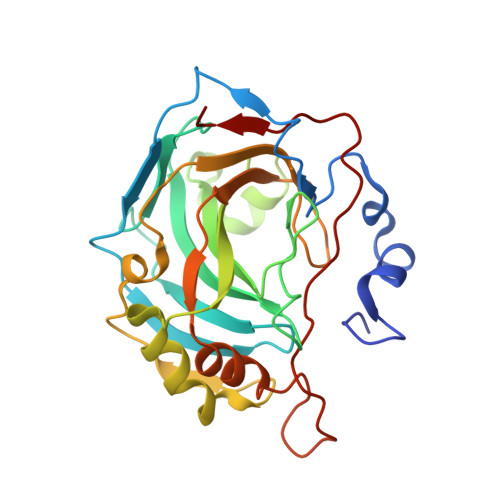Structural insight into activity enhancement and inhibition of H64A carbonic anhydrase II by imidazoles.
Aggarwal, M., Kondeti, B., Tu, C., Maupin, C.M., Silverman, D.N., McKenna, R.(2014) IUCrJ 1: 129-135
- PubMed: 25075329
- DOI: https://doi.org/10.1107/S2052252514004096
- Primary Citation of Related Structures:
4HEW, 4HEY, 4HEZ, 4HF3 - PubMed Abstract:
Human carbonic anhydrases (CAs) are zinc metalloenzymes that catalyze the hydration and dehydration of CO2 and HCO3 (-), respectively. The reaction follows a ping-pong mechanism, in which the rate-limiting step is the transfer of a proton from the zinc-bound solvent (OH(-)/H2O) in/out of the active site via His64, which is widely believed to be the proton-shuttling residue. The decreased catalytic activity (∼20-fold lower with respect to the wild type) of a variant of CA II in which His64 is replaced with Ala (H64A CA II) can be enhanced by exogenous proton donors/acceptors, usually derivatives of imidazoles and pyridines, to almost the wild-type level. X-ray crystal structures of H64A CA II in complex with four imidazole derivatives (imidazole, 1--methylimidazole, 2--methylimidazole and 4-methylimidazole) have been determined and reveal multiple binding sites. Two of these imidazole binding sites have been identified that mimic the positions of the 'in' and 'out' rotamers of His64 in wild-type CA II, while another directly inhibits catalysis by displacing the zinc-bound solvent. The data presented here not only corroborate the importance of the imidazole side chain of His64 in proton transfer during CA catalysis, but also provide a complete structural understanding of the mechanism by which imidazoles enhance (and inhibit when used at higher concentrations) the activity of H64A CA II.
Organizational Affiliation:
Department of Biochemistry and Molecular Biology, University of Florida , PO Box 100245, Gainesville, FL 32610, USA.
















